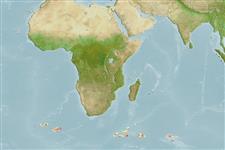Holocephali (chimaeras) (chimaeras) >
Chimaeriformes (Chimaeras) >
Chimaeridae (Shortnose chimaeras or ratfishes)
Etymology: Hydrolagus: hydro-, combining form of hydor (Gr.), water; lagos (Gr.), hare, i.e., “water rabbit,” probably referring to three pairs of tooth plates, which tend to protrude from the mouth like a rabbit’s incisors. (See ETYFish); erithacus: Erithacus, avian genus of the robin, named after Robin Leslie, South African Department of Agriculture, Forestry and Fisheries, a “fanatic birder,” for his help and support with the authors’ project and his overall contribution to Chondrichthyan re (See ETYFish).
Environment: milieu / climate zone / depth range / distribution range
Ekologi
laut batidemersal; kisaran kedalaman 470 - 1000 m (Ref. 116866). Deep-water; 39°S - 47°S (Ref. 116866)
Penyebaran
Negara-negara | Daerah-daerah FAO | Ecosystems | Kemunculan | Point map | Introduksi | Faunafri
Southeastern Atlantic and southwestern Indian oceans.
Size / Weight / umur
Maturity: Lm ? range ? - ? cm
Max length : 132 cm TL jantan/; (Ref. 116866); 144.2 cm TL (female)
deskripsi pendek
Morfologi | Morfometrik
This species is distinguished from its congeners by the following set of characters: bulky and relatively large head is followed by a stocky body; head and body height consistent from about pectoral fin origins to pelvic fin origins, until the insertion of the pelvic fins, tapering rapidly to filamentous tail; height of first dorsal fin spine about equal to or slightly less than first dorsal fin apex height; second dorsal fin up to 81% of total body length, uniform in height, and equal to dorsal caudal fin height; paired claspers trifurcate, forked for approximately 20% of total length with fleshy, bulbous tips; prepelvic tenaculae with 5-7 medial spines; robust frontal tenaculum, nearly uniform in width; color when preserved uniform black with no distinct markings (Ref. 116866).
This species is likely to occur beyond 2,000 meters. Fragments of possible crab appendages recovered from a digestive tract indicate a diet of crustaceans and other benthic fauna (Ref. 116866).
Life cycle and mating behavior
Kematangan | Reproduksi, perkembang biakan | Pemijahan | telur-telur | Fecundity | Larva
Walovich, K.A., D.A> Ebert and J.M. Kemper, 2017. Hydrolagus erithacus sp. nov. (Chimaeriformes: Chimaeridae), a new species of chimaerid from the southeastern Atlantic and southwestern Indian oceans. Zootaxa 4226(4):509-520. (Ref. 116866)
Status IUCN Red List (Ref. 130435)
ancaman kepada manusia
Harmless
penggunaan manusia
informasi lanjut
Negara-negaraDaerah-daerah FAOEcosystemsKemunculanIntroduksiStocksEkologiMakananBahan makananKonsumsi makananJatah
Nama-nama umumSinonim (persamaan)metabolismePemangsaEkotoksikologiReproduksi, perkembang biakanKematanganPemijahanSpawning aggregationFecunditytelur-telurpekembangan telor
Umur / SaizPertumbuhanpanjang-beratpanjang-panjangukuran frekuensiMorfometrikMorfologiLarvaDinamika larvapemulihanKelimpahanBRUVS
AcuanBudidaya airprofil budidaya airStrainGenetikaElectrophoresesDiturunkanPenyakit-penyakitPengolahanNutrientsMass conversion
mitraGambarStamps, Coins Misc.Suara-suaraCiguateraKecepatanTipe renangArea insangOtolithsOtakPenglihatan / visi
Alat, peralatan
laporan khas
muat turun XML
Sumber internet
Estimates based on models
Phylogenetic diversity index (Ref.
82804): PD
50 = 0.5000 [Uniqueness, from 0.5 = low to 2.0 = high].
Bayesian length-weight: a=0.00282 (0.00118 - 0.00673), b=3.10 (2.89 - 3.31), in cm total length, based on LWR estimates for this (Sub)family-body shape (Ref.
93245).
Trophic level (Ref.
69278): 4.0 ±0.6 se; based on size and trophs of closest relatives
Daya lenting (Ref.
120179): sangat rendah, Waktu penggandaan populasi minimum lebih dari 14 tahun (Preliminary K or Fecundity.).
Fishing Vulnerability (Ref.
59153): Very high vulnerability (87 of 100).
